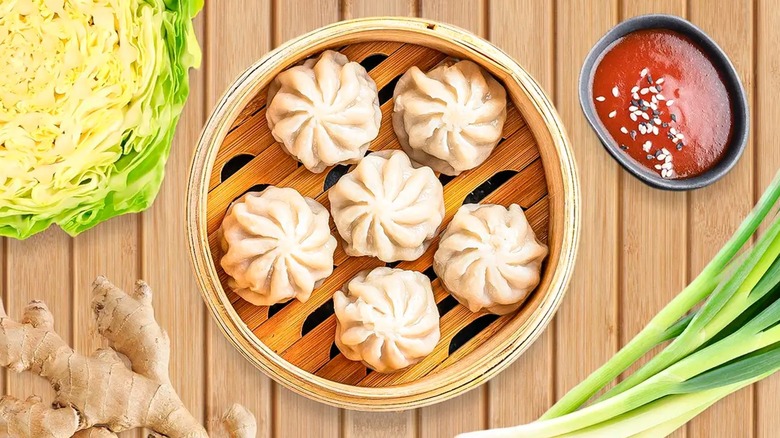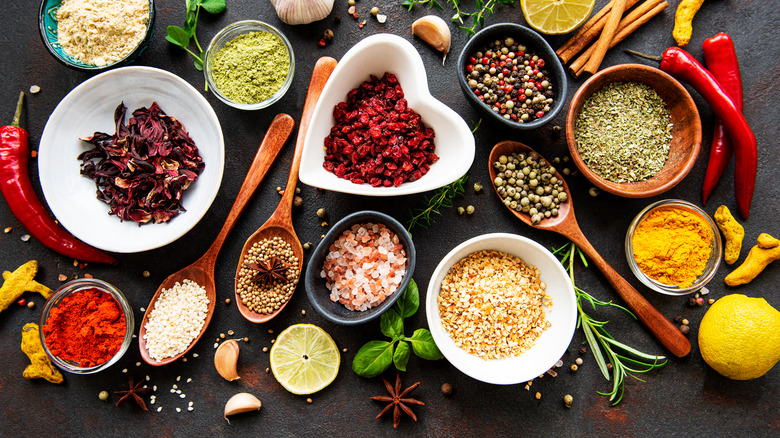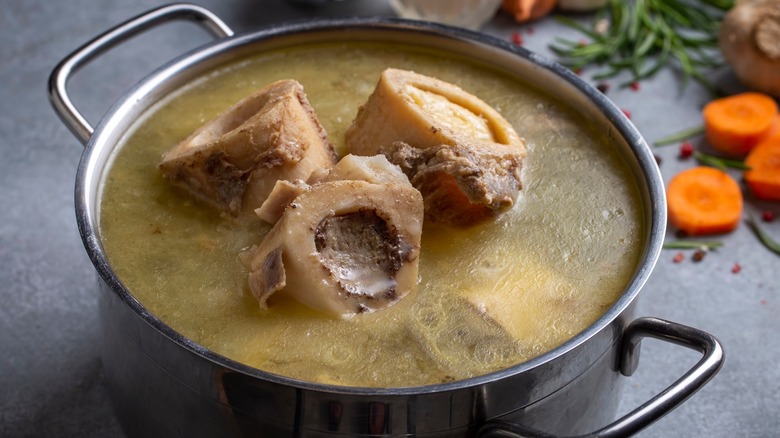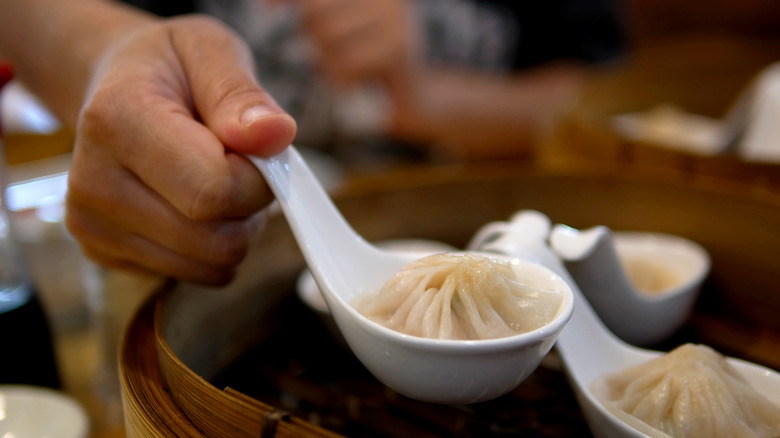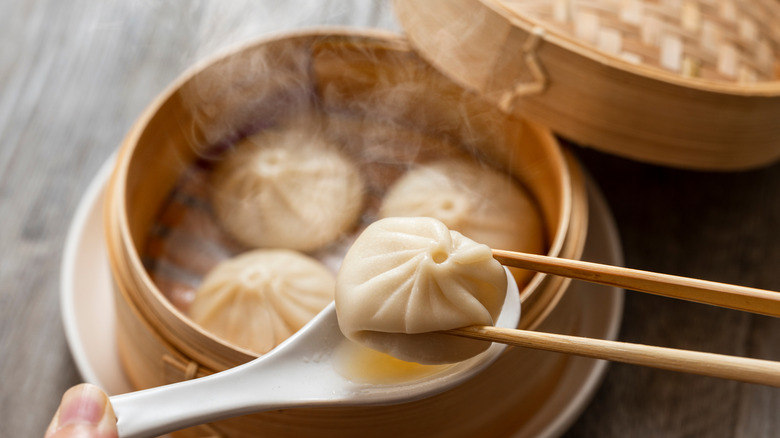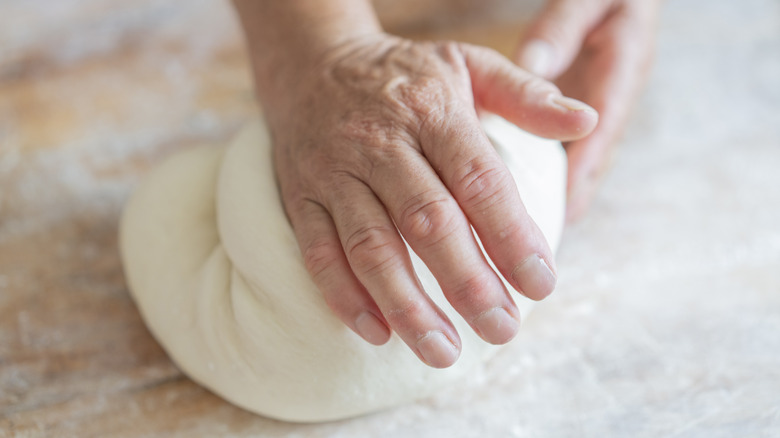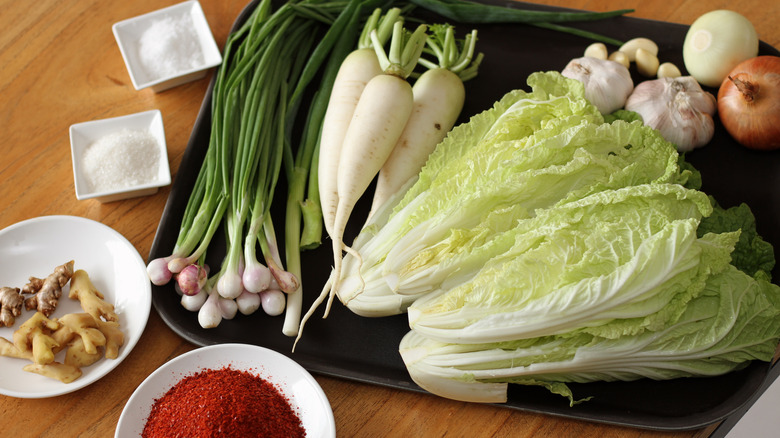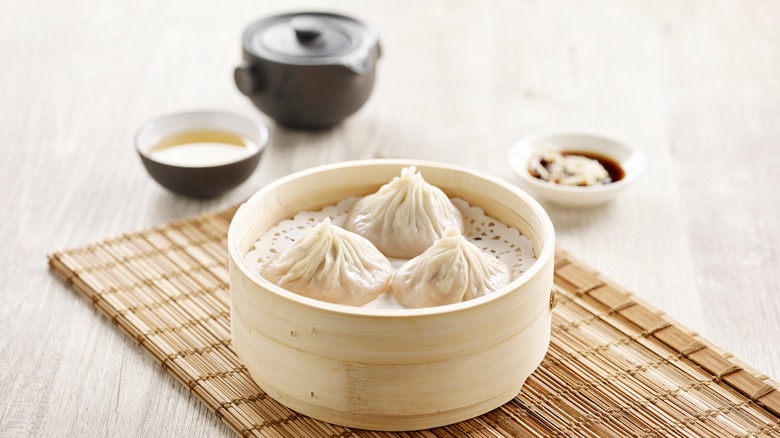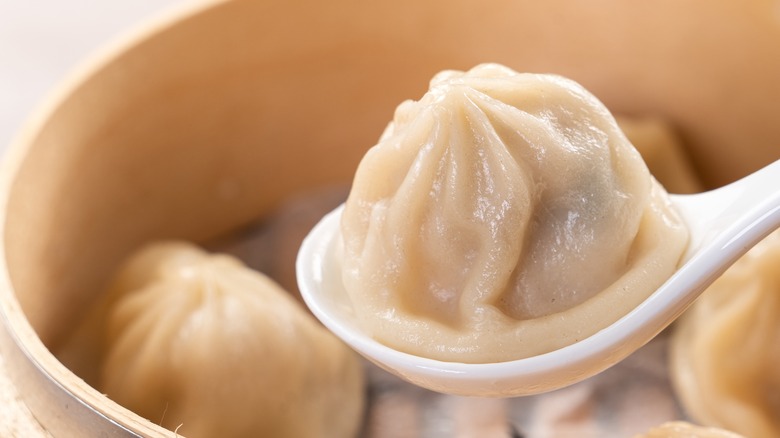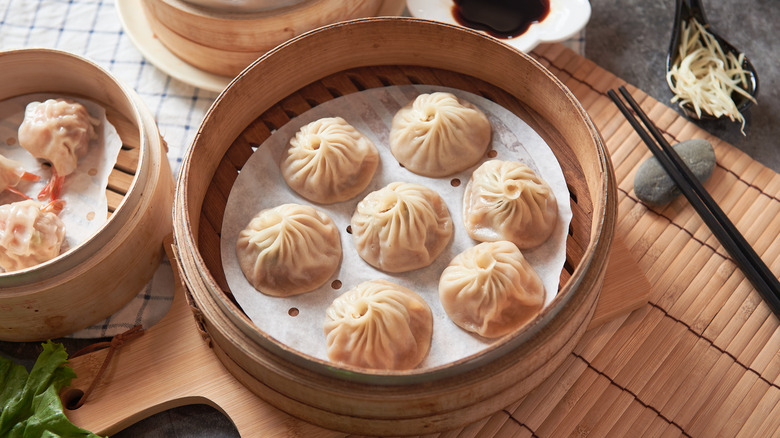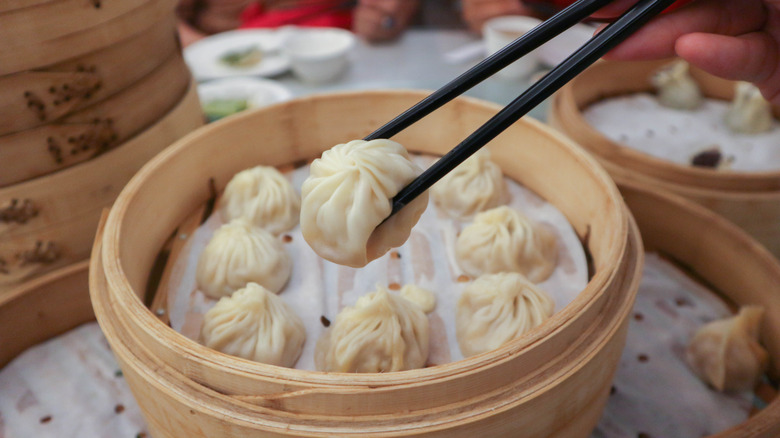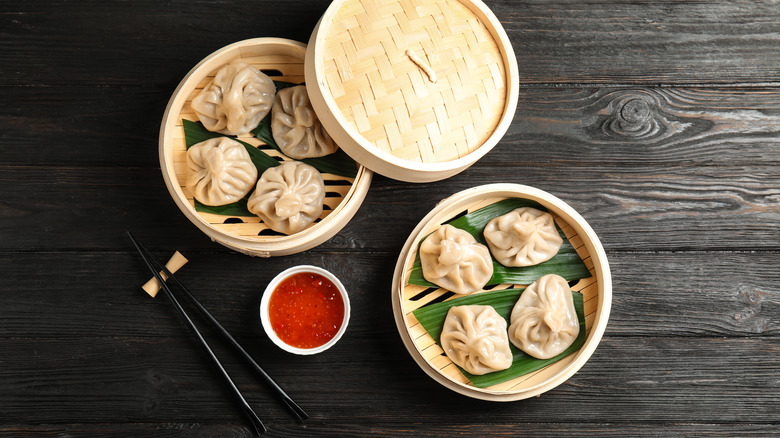12 Best Ways To Upgrade Soup Dumplings
Dumplings are one of those amazing things, capable of evoking the sense of filling, warming, and creating a sense of incomparable comfort. We're not only talking about sating your appetite but also catering to the cravings of your very heart, which is as equally affected as your stomach. When it comes to this ingredient, there are numerous cultural varieties of different kinds of dumplings to choose from, and each is as comforting as the last. From matzo ball soup to the chicken n' dumpling soup popular in the Southern United States, it can be hard to choose a favorite — but not impossible.
Xiao long bao is a traditional Chinese soup dumpling dish with a twist. Unlike most of the dumplings-in-soup of the world, xiao long bao dumplings contain the actual soup within the confines of their dumpling wrapper. In other words, all that amazingly sumptuous, comforting, soupy stock is inside the dumpling rather than just surrounding it. When you take that first bite, your mouth is practically flooded with hot, flavorful broth so delicious that you may never want to stop eating (even when the soup dumplings are scalding hot).
So, of all the soup dumplings in all the soup dumpling joints in the world, let's address how to upgrade the most aptly-named soup dumplings of all. How can you elevate something that already is a nearly perfect pouch of soup, spice, and everything nice? Let's find out!
1. Use quality, seasonal ingredients
Aside from mastering some techniques, you should know that xiao long bao dumplings are incredibly simple to cook, even from scratch; it's possible to make at least passingly well, given some studying and effort. Perfecting this special soup dumpling, however, is something else entirely. To truly upgrade those soup dumplings, you need to nail every step of the recipe. When considering upgrades, there is no better place to begin than with the very ingredients you combine to comprise the soup dumpling dish.
No matter what recipe you plan to follow — or what flavors you want to play around with — soup dumplings shine brightest when made from fresh, seasonal ingredients. This is because xiao long bao is, like most global dumpling dishes, a reflection of the culturally and seasonally available produce in and around a surrounding area. For example, pork and chive dumplings are a great way to embrace the bounty of spring. Or, during the cold winter months, include some warming spices in your filling.
One mistake some make with soup dumplings is using unfamiliar, possibly not-so-fresh ingredients or imported items that are either out of season or past the expiration date. However, if you go to a local farmers market and select your fillings based on what's available, you're more likely to create an authentic tasting, fresh, and delicious soup dumpling.
2. Make your own broth
Homemade broth is essential to many recipes, and soup dumplings are certainly not exempt from this rule. When you consider that soup dumplings contain some broth, it's a fair point to make that these delicate packages are one of the most important cases where you should avoid boxed, store-bought stock at all costs.
Making homemade broth is simple — and soup dumpling broth only requires one extra step of consideration to ensure the most excellent results. If you haven't guessed, that step is to make the stock extra thick, allowing it to be stuffed inside the dumpling wrapper before being steamed. This is achieved by creating a homemade stock that is very high in fat and collagen, usually from chicken or pork, and reducing it into a liquid that will cool and thicken into a texture similar to Jell-O. This texture is particularly desirable, as it allows the broth to be cut up and mixed into the soup dumpling mixture before being wrapped. As the dumplings cook, the broth will melt, melding into the other fillings and flavors and transforming into the beautiful bite we all know and crave.
3. Leave out the artificial gelatin
Using artificial gelatin in your made-from-scratch soup dumpling recipe is a bit of a misstep. It's so simple to make your own that it's almost inconceivable to use the same stuff that goes into sweet jellies in soup dumplings, too. Why use a completely flavorless powder without a single nutritional benefit to its name when you can extract all the tastes and beneficial qualities of real-life ingredients instead?
As previously mentioned, to make the right kind of homemade stock for soup dumplings, you must ensure it is high in fat and collagen. This is because your goal is to create a broth so rich and thick that it cools into a jelly. You may remember a cold Thanksgiving broth or gravy that wobbles when you wiggle it. That's the texture to aim for with your ideal soup dumpling stock.
Instead of artificial gelatin, use products like chicken feet or pork jowl, belly, and hock. Essentially, any part of the pig or poultry (or possibly beef) you choose to make your stock should be high in bone, fat, connective ligaments, cartilage, etc. To best extract these naturally gelatinous components, cook the broth low and slow, leaving the lid off, which results in an evaporated and condensed stock, perfect for cubing (once chilled).
4. Aim for all-around high fat content
Fat is flavor; this is an undisputed fact in the culinary world. The soup dumpling is no exception to this rule, especially since the broth must explode with flavor (and the fat that binds it). As discussed previously, the broth's fat and collagen content holds the entire soup dumpling concept together.
Without fat, there would be no way to get the filling into your soup dumplings in the first place. Unless, of course, you want to involve a syringe. Indeed, this instrument would require twice the work plus the stress of staging a post-cooking, pre-eating intermission to fill every dumpling before serving. In other words, it would make no sense to use a syringe to fill soup dumplings when a simple aspic will do.
Since we can all agree that added fat is added flavor, we recommend buying a mince that is as fatty as desired. The ideal cuts of meat for this application will have a lot of fat marbling throughout and can come from belly, rump, and cheek cuts. Alternatively, the proportions of meat to fat you desire can be achieved by including a slab of pure fat with an otherwise lean meat grind.
5. Use homemade dough, you know?
To upgrade your soup dumpling game, we recommend starting entirely from scratch. In the same way that a good sandwich can only become great if the base bread holding it all together is as excellent as its filling, a soup dumpling can only go from good to great if the dough is homemade and high quality. Luckily, making soup dumpling dough is significantly easier than just about any other kind of dough. It only calls for two ingredients: hot water and flour (all-purpose flour is fine).
To make perfect soup dumpling dough every time, mix about 1 cup of flour with 6 tablespoons of hot water, one spoonful at a time. Stir the mixture thoroughly with chopsticks between each spoonful to fully integrate the liquid throughout the flour. Depending on the humidity and a few other factors, the recipe may call for more or less of either ingredient; adjustments can and should be made as you knead for about 10 minutes. At that point, you should be left with a soft, supple dough ball. This dough shouldn't be too dry and should not be at all sticky to the touch. Once you're done kneading, wrap the dough tight and let it rest for at least 45 minutes at room temperature before rolling it into dumpling wrappers.
6. Fresh herbs are best
Soup dumplings are one of those foods that require few ingredients, meaning it is extra important to use fresh herbs instead of dried ones. This will help the flavors pop through and shine, even in something as seemingly simple and savory as a soup dumpling. While there is a time and place for some dried herbs here and there, such as white pepper, you'll want to aim for fresh herbs when working with ingredients like cilantro, chives, garlic, green onions, and so on.
Forgoing dried, powdered aromatics and opting to use the fresh versions instead allows you to create a better stock. For example, elevating stock with fresh ginger will create a finished product that is leagues better than one without ginger — or that only uses the dried kind.
If you use fresh herbs to make your soup dumplings, their freshness will carry over into the flavor across every bite. There's something special about the intermingled flavors of fresh herbs combined with savory meat and broth, which all meld together in your mouth to taste like the best elements of the fresh herbs and add life to an otherwise less punchy-tasting treat.
7. Roll that dumpling wrapper thin
When aspiring to cook perfectly textured soup dumplings from scratch, you must achieve a thin (but not too thin) wrapper that can contain all that delicious filling without losing its shape or absorbing all the liquid inside. There is a balance to strike between a soup dumpling wrapper that is too thin and not thin enough, and only practice will make you capable of perfecting the dumpling wrapper ratio.
Some basic principles can help you start your soup dumpling wrapper rolling journey with as little room for trial and error as possible. First, you'll want to check that your dumpling wrappers are about the same size for consistency's sake. You can achieve this by either weighing out individual pieces of dough as you go or, if you don't have a kitchen scale, taking your ball of dough, cutting it in half, cutting each of those pieces in half, and so on until each desired segment of dough is separated and ready to go.
For the actual rolling, make sure the dough is dry enough that it does not stick to your rolling pin with a small sprinkling of flour on the rolling surface and pin. Before you go and roll all the soup dumpling wrappers, try out a tester or two to get a sense of your wrapper's consistency.
8. Use less filling than you think you'll need
The first time anyone makes any stuffed item, whether it be a soup dumpling, ravioli, or various stuffed pasta dishes, the biggest surprise most face is discovering how little filling is needed. It takes some practice to nail down how much filling should go into your dumplings; everyone's soup dumpling wrapper size will vary, as will their technique in pinching it shut.
As a general rule of thumb for soup dumpling size and filling, consider an average mouthful of food and aim for how much you could reasonably eat in one bite. On average, this size should be a spoon-sized, circular dollop about as big as a quarter in height and width. Your filling should comfortably rest in the center of the wrapper while leaving ½-inch of space around the dough's edge for pinching purposes. Again, practice makes perfect. Don't despair if you have to spend extra time making that soup dumpling filling-to-wrapper ratio just right.
As an extra note, be careful when you're closing up those dumplings and take precautionary steps to ensure everything inside is filling and not an air pocket, which could make the dumpling expand and break open during the cooking process — or give a disappointingly empty bite of dumpling that is half filling, half air.
9. Practice makes perfect (for the pinch)
The concept of practice making perfect spans the entire culinary sphere. In the same way that you will need to perfect searing steaks before you can make a sensationally seared one consistently, it is equally important to practice your pinch for closing up those soup dumplings.
There are many ways people commonly make mistakes in the pinching process, which involves sealing off the top of the soup dumpling; an improper technique can undo everything (literally). After all, what exactly is a soup dumpling worth if all of the soup has bubbled out of the top before you've even lifted the lid of your steamer? Or what if the pinched portion of dough at the top is so thick and clunky that it's still raw in the center when everything else is perfectly cooked?
To properly pinch a soup dumpling shut and preserve all the deliciousness inside, you should follow some professional soup dumpling tips and, again, practice. The proper pinching technique will vary from person to person. Generally speaking, you'll want to comfortably cup the un-sealed soup dumpling in your hand, choose a place to start the pinching process, gently squeeze, and seal a section between your two fingers into a folded crease called a pleat. After creating your first pleat, move to either side and press the next section into the first pleat. Continue this process around the dumpling until it is sealed at the top.
10. Steam with a separation layer
If you're steaming your soup dumplings, which you absolutely should if you plan to make them from scratch, it is essential to remember to include a layer between the dumplings and the heat source underneath. This layer serves to not only protect the bottom of the dumpling from overcooking — or even disintegrating — but also helps ensure you can remove it in one piece from the steaming apparatus.
The alternative would be the possibility of the bottom of the soup dumpling sticking to the cooking surface. Since the slightest tear could result in a complete and total loss of broth, this layer is critically important. The different methods for creating a steaming separation layer for soup dumplings include, but are not limited to, cabbage leaves, parchment paper, and banana leaves. You can improvise with whatever tool you prefer for this soup dumpling project so long as it is food-safe, thin, and able to stand up to the steaming it will soon face.
11. Don't let them sit
After all that work you've put into upgrading your soup dumpling game, the biggest shame would be allowing them to sit for even a second longer than it takes to get them from the steamer and straight onto your taste buds. This rush is for a few reasons, starting with the sheer joy of eating a fresh, steaming hot soup dumpling straight from the source. Indeed, letting them sit too long is one of the biggest mistakes people make when eating soup dumplings.
However, there are a few other reasons you want to ensure your homemade dumplings are dished out quickly. For instance, the simple fact that they will eventually lose their juice to the wrapper or evaporation. Either way, the most soupy bites are to be had at the beginning of a soup dumpling's life. After that, it's all a race against time — and the broth running dry.
Although fresh soup dumplings may seem scaldingly hot to some of us, it's primarily because there's a certain way in which they are meant to be eaten: with a spoon. The big soup spoon helps you hold the soup dumpling up for a bite and maybe a slurp before letting the rest of the broth gather under the dumpling to cool to a temperature you can consume without scalding yourself.
12. Serve with a special dipping sauce (and a big spoon!)
When creating the perfectly upgraded xiao long bao experience, the only thing more important than the soup dumpling is the sauce with which you serve it. Of course, most well-made soup dumplings are delicious enough to stand alone, given their flavorful broth and minced meat filling. But why should a soup dumpling be eaten bare when it can be dipped, dripped, or otherwise smothered in a sauce so good that it could almost be an incredibly spicy soup in its own right? No xiao long bao should have to go without a dipping sauce.
There are numerous varieties of soup dumpling dipping sauces, though a common theme is the dynamic interplay of spicy, sweet, savory, fresh, and other complex, complementary flavors. The easiest option is plain soy sauce. Or, you can try making a simple dumpling sauce recipe with few ingredients. Alternatively, you could go for a more complex dipping sauce by combining chilis, garlic, and all your favorite spices before pouring hot oil over the whole thing, activating all those flavors to crave-worthy results.
For example, complementary pairings could include shrimp dumplings with a zingy, herbaceous lemongrass soy sauce or pork and chive dumplings with a spicy chili dip. Or, for something a little more unique, try pairing a peanut-based sauce with some chicken and ginger dumplings. The only limit is your imagination!
